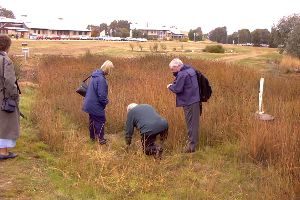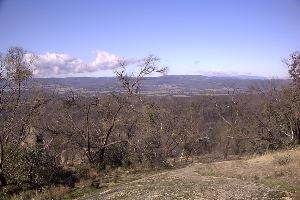|
I've been spending a lot of time at the universities. Universities are a great place to hang out when you want to get a really skewed view of a society and culture. I thought it was a good place to start. In Albury (actually, it is a community called Thurgoona), I've been visiting Charles Sturt University (CSU) and Riverina TAFE. Both CSU and TAFE are large school systems that have many campuses (although there are 35,000 students in all of the New South Wales TAFEs combined, and there are 350,000 students in the Maricopa Community Colleges where I work). They both happen to have a campus in Thurgoona that I had the opportunity to visit. TAFE is more of a trade or technical college (carpenters, sheet metal workers, horticulturists, managing livestock, etc.), while CSU is a classic 4 year university.
 The interesting thing about both of these campuses is that they are built in an extremely environmentally friendly way. When CSU was built, there was no infrastructure to a portion of the build site. So, they didn't have to hook up to the city sewer system. The result is that all of the toilets on the new portion of campus are composting toilets. All of the greywater is also collected and run through a series of wetlands and natural filtration systems, producing an amazingly clean and usable water source. They have large collection systems for rainwater, which is their primary source of drinking water. All the building materials are recycled, including timbers, bookcases, and railings. The heating and cooling system is really interesting too, and it made me start thinking about the buildings being built all over the Phoenix valley. We could really use some new ideas as to how to cool buildings without using so much energy. CSU was employing a lot of simple, yet unique, technologies and it's WORKING. What a beautiful model. I was always a bit skeptical of composting toilets, for fear of the smell and flies and all of the associated nastiness. But, it was working beautifully (and aromatically), but I'm glad I didn't drop my wallet down the commode by mistake. You can read more about the CSU campus at www.csu.au.edu. The TAFE campus was equally interesting, as they employ different environmental technologies to heat and cool their buildings. What a brilliant educational opportunity! Over the next few decades, I think these two campuses will push the idea of green building by being successful independently working models, as well as being able to compare between the two campuses. The interesting thing about both of these campuses is that they are built in an extremely environmentally friendly way. When CSU was built, there was no infrastructure to a portion of the build site. So, they didn't have to hook up to the city sewer system. The result is that all of the toilets on the new portion of campus are composting toilets. All of the greywater is also collected and run through a series of wetlands and natural filtration systems, producing an amazingly clean and usable water source. They have large collection systems for rainwater, which is their primary source of drinking water. All the building materials are recycled, including timbers, bookcases, and railings. The heating and cooling system is really interesting too, and it made me start thinking about the buildings being built all over the Phoenix valley. We could really use some new ideas as to how to cool buildings without using so much energy. CSU was employing a lot of simple, yet unique, technologies and it's WORKING. What a beautiful model. I was always a bit skeptical of composting toilets, for fear of the smell and flies and all of the associated nastiness. But, it was working beautifully (and aromatically), but I'm glad I didn't drop my wallet down the commode by mistake. You can read more about the CSU campus at www.csu.au.edu. The TAFE campus was equally interesting, as they employ different environmental technologies to heat and cool their buildings. What a brilliant educational opportunity! Over the next few decades, I think these two campuses will push the idea of green building by being successful independently working models, as well as being able to compare between the two campuses.
 While at Riverina TAFE I had a unique opportunity to visit with some of the faculty. I attended a native plant recognition class, and that was really interesting. The native Australian vegetation is amazing. Apparently Australia has incredibly variable rainfall. I looked at a rainfall chart which documented the past 100 years of annual rainfall and deduced an "average" for the area. In the past 100 years, the annual rainfall has only been in the "average" range twice. Currently they are in the middle of a 7 year drought in the area, although up in Queensland they are experiencing a big "wet", which I think means that they are having some problems with flooding. As a result, the vegetation has some crazy adaptations. I was taken to an area that was burned 18 months ago, but was so thick with new vegetation that I was having difficulty finding a clear path through the burn site. In fact, the entire area had been burned down, but I was looking at a green forest...in the middle of a drought. While at Riverina TAFE I had a unique opportunity to visit with some of the faculty. I attended a native plant recognition class, and that was really interesting. The native Australian vegetation is amazing. Apparently Australia has incredibly variable rainfall. I looked at a rainfall chart which documented the past 100 years of annual rainfall and deduced an "average" for the area. In the past 100 years, the annual rainfall has only been in the "average" range twice. Currently they are in the middle of a 7 year drought in the area, although up in Queensland they are experiencing a big "wet", which I think means that they are having some problems with flooding. As a result, the vegetation has some crazy adaptations. I was taken to an area that was burned 18 months ago, but was so thick with new vegetation that I was having difficulty finding a clear path through the burn site. In fact, the entire area had been burned down, but I was looking at a green forest...in the middle of a drought.
Clive Vogel, the Riverina TAFE resident geologist, took me on a fantastic hike up "The Rock" with a group of his students for a geology outing. I was relieved to see that Australian students are just as lazy as American ones. They were "winge-ing" (complaining) about having to hike and participate in the class. Clive turned to me and said, "tell me they are like this in the U.S." Oh yeah Clive, you have no idea. It was nice to talk with the students about their perceptions of the differences between Americans and Australians. They said that Americans work too hard (yeah, right...) and Australians are really lazy, which is evident by the way that Australians speak.
Language note:
The Australian accent, I'm told, is a result of trying to open your mouth as little as possible. Though I have conflicting reports on this point...some say that they open their mouth very little because they are lazy and others say that it is to keep the flies out of their mouths. But the result is that a soft "r" sound ends up on the words that end in open vowel sounds. For example, the word "no". Say it, and then cut off the word by closing your mouth. The result is this little "r" on the end. Try it, it's amazing.
Anyway, I found their comments interesting, since I don't perceive Americans as being particularly hard working. But they further supported their statements by pointing out that Australia stops operating at 10:30 every morning for tea. It's a good point, because it is true. I am leaving Albury and heading for the small town of Deniliquin this week. When I tell people I am going there, they all ask why, and then they say, "there aren't any rocks in Deni." Hmmmm, it sounds like the perfect place to go.
|